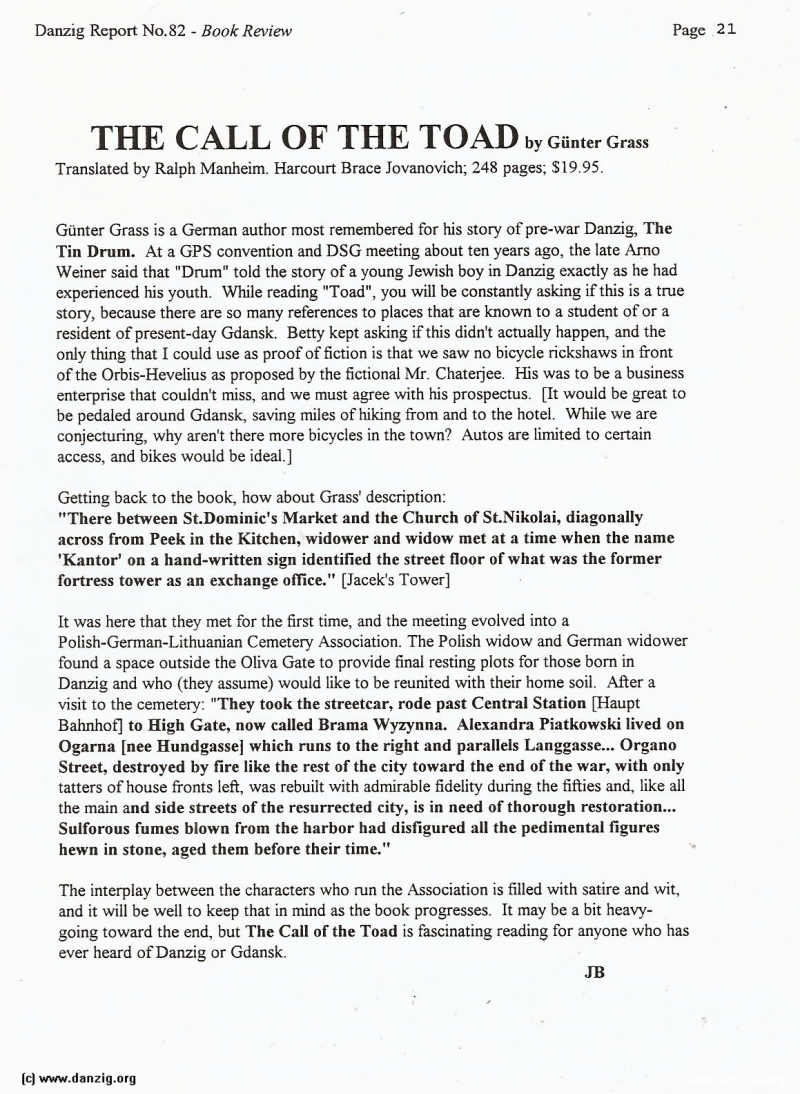
THE CALL OF THE TOAD by Gunter Grass
Translated by Ralph Manheim. Harcourt Brace Jovanovich; 248 pages; $19.95.
Günter Grass is a German author most remembered for his story of pre-war Danzig, The Tin Drum. At a GPS convention and DSG meeting about ten years ago, the late Arno Weiner said that “Drum” told the story of a young Jewish boy in Danzig exactly as he had experienced his youth. While reading “Toad”, you will be constantly asking if this is a true story, because there are so many references to places that are known to a student of or a resident of present-day Gdansk. Betty kept asking if this didn’t actually happen, and the only thing that I could use as proof of fiction is that we saw no bicycle rickshaws in front of the Orbis-Hevelius as proposed by the fictional Mr. Chaterjee. His was to be a business enterprise that couldn’t miss, and we must agree with his prospectus. [It would be great to be pedaled around Gdansk, saving miles of hiking from and to the hotel. While we are conjecturing, why aren’t there more bicycles in the town? Autos are limited to certain access, and bikes would be ideal.1
Getting back to the book, how about Grass’ description:
“There between St.Dominic’s Market and the Church of St.Nikolai, diagonally across from Peek in the Kitchen, widower and widow met at a time when the name ‘Kantor’ on a hand-written sign identified the street floor of what was the former fortress tower as an exchange office.” [Jacek’s Tower]
It was here that they met for the first time, and the meeting evolved into a
Polish-German-Lithuanian Cemetery Association. The Polish widow and German widower found a space outside the Oliva Gate to provide final resting plots for those born in Danzig and who (they assume) would like to be reunited with their home soil. After a visit to the cemetery: “They took the streetcar, rode past Central Station [Haupt Bahnhof] to High Gate, now called Brama Wyzynna. Alexandra Piatkowski lived on Ogarna [flee Hundgassel which runs to the right and parallels Langgasse... Organo Street, destroyed by fire like the rest of the city toward the end of the war, with only tatters of house fronts left, was rebuilt with admirable fidelity during the fifties and, like all the main and side streets of the resurrected city, is in need of thorough restoration... Sulforous fumes blown from the harbor had disfigured all the pedimental figures hewn in stone, aged them before their time.”
The interplay between the characters who run the Association is filled with satire and wit, and it will be well to keep that in mind as the book progresses. It may be a bit heavy- going toward the end, but The Call of the Toad is fascinating reading for anyone who has ever heard of Danzig or Gdansk.
Danzig Report Vol. 1 - Nr. 82 - January - February - March - 1994, Page 23.
Hits: 1649
Added: 06/07/2015
Copyright: 2024 Danzig.org

